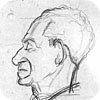|

|
Cedric Morris
Sir Cedric Lockwood Morris, 9th Baronet (11 December 1889 - 8 February 1982) was a Welsh artist, known for his portraits, flower paintings and landscapes, and an eminent plantsman.
Early life
Morris was born in Sketty, Swansea, the son of George Lockwood Morris, ironfounder and Welsh rugby international, and his wife Wilhelmina Cory. He was educated at St Cyprian's School Eastbourne and Charterhouse. He failed the exams to enter the army and at the age of 17 set out on a steamship to Ontario, Canada to work on a farm. After a succession of jobs, including as a dishwasher and bell boy in New York, he returned to Wales and entered the Royal College of Music to study singing. He gave up singing for painting and went to Paris where he trained briefly at the Academie Delacluse in Montparnasse before the interruption of World War I. He joined the Artists Rifles, but failed a medical examination before embarking for France as a result of a failed operation in childhood. As he was an experienced horseman, he was allocated to training Remounts at Lord Rosslyn's stables at Theale, Berkshire. He worked in the company of Alfred Munnings, under Cecil Aldin. He was discharged when the army took over the Remounts in 1917.
Cornwall, Paris and London
Morris went to Zennor in Cornwall where he studied plants and painted water colours. There he became friendly with Frances Hodgkins whose portrait he painted. He was in London at the time of the Armistice in November 1918 when he met Arthur Lett-Haines with whom he began a life-time relationship, and shortly after moved in with Haines and his wife. The trio planned to go to America, but in the event Aimee Lett-Haines left on her own and the two men moved to Cornwall. They converted a row of cottages at Newlyn into a larger house and stayed there until the end of 1920 when they moved to Paris.
Paris was their base for the next five years, when they travelled extensively in Europe. Morris also studied at the Academies Moderne and La Grande Chaumiere. Morris had successful exhibitions in London in 1924 and 1926 and later in that year they settled back in England.
After staying with his sister Nancy Morris in Corfe Morris and Haines found a studio in Great Ormond Street which they moved into in 1927. Morris became a member of the London Artists Association and the Seven and Five Society for which he was proposed by Winifred Nicholson and seconded by Ben Nicholson. He was especially friendly with Christopher Wood and renewed friendship with Frances Hodgkins. At the end of the 1920s Morris became involved with much commercial work designing textiles for Cresta Silks with Paul Nash and posters for Shell and B. P.
Country life
Morris chose the country life to pursue his passion for horticulture. Early in 1929 Morris and his companion took the lease of Pound Farm, Higham, Suffolk, and in February 1930 they gave up the London studio. In 1932 the owner of Pound Farm, who was for a while a student, died and left it to Morris. Morris resigned from the Seven and Five Society in 1930 and from the London Artist's Association in 1933. There were many visitors at Pound Farm, including Frances Hodgkins, Barbara Hepworth and John Skeaping. Joan Warburton who was a student described Pound Farm as a paradise, mainly because of the spectacular gardens which Morris developed. She also was also impressed by their spectacular parties. Morris often went painting in his native Wales and in 1935 at the time of the Depression was moved by the plight of the people of South Wales. He initiated a major touring exhibition of Welsh art in 1935 and was a regular teacher at Mary Horsfall's Art's centre at Merthyr Tydfil. In 1935 he painted two large flower murals on board the liner Queen Mary.
In late 1937 Morris and Haines joined the Hadleigh Labour Party after attending a meeting addressed by Professor Catlin.
East Anglian School of Painting and Drawing
Morris and Lett-Haines opened the East Anglian School of Painting and Drawing at Dedham in April 1937. Within a year they had 60 students. Lucian Freud was one of his most noted students. The building at Dedham was destroyed by fire in 1939 (with several of Morris's paintings also destroyed) to the conspicuous enjoyment of Alfred Munnings. By the end of the year the school was reestablished at Benton End.
Benton End was a rambling 'Suffolk Pink' farmhouse on the outskirts of Hadleigh, set in three or 4 acres (16,000 m2) of orchard. In addition to running the school, Morris indulged his passion for plants. He grew about 1000 new Iris seedlings each year and opened the house to display his collection, and used to walk the fields and hedgerows searching for softer colour variants of poppies. Morris's work as a horticulturalist resulted in a number of plants being names after him.
Morris was intolerant of cruelty to animals and at Benton End had a running feud with a local gamekeeper who shot cats and dogs - until the latter tripped over his shotgun and shot himself.
Later life
In 1947 the Morris baronetcy came to his father from a distant cousin three months before his death and Cedric Morris succeeded his father in the same year to become the 9th Baronet Morris. He became a lecturer at the Royal College of Art in 1950.
In 1984 the Tate Gallery held a retrospective exhibition of Morris's work.
Morris had a distinctive and often rather primitive post-Impressionist style, and painted portraits, landscapes and very decorative still-lifes of flowers and birds. As a portrait painter, he produced notable studies of subjects such as Rosamond Lehmann (1932) and Lucian Freud (1940).
List of works in public galleries
- Frances Hodgkins 1917 Tate
- Self Portrait 1919 National Museum Cardiff (NMGW)
- Patisseries and a croissant 1922 Tate
- Experiment in textures 1923 Tate
- Landscape:Vallee de L'Oueze 1925 NMGW
- From a window at 45 Brook Street London 1926
- Self Portrait 1930 NPG
- Solva 1934 Norwich
- Antonia White 1936 NPG
- David and Barbara 1940 Tate
- Stoke by Nayland Church 1940 NMGW
- Lucien Freud 1941 Tate
- Peregrine Falcons 1942 Tate
- Iris Seedlings 1943 Tate
- Eggs 1944 Tate
- Belle of Bloomsbury 1948 Tate
List of plants named after Cedric Morris
- Iris (Sir Cedric Morris introductions)
- Papaver rhoeas Cedric Morris
- Sir Cedric Morris (Bare Root Rose)
- Sir Cedric Morris Hardy Geranium
- Narcissus minor 'Cedric Morris'
- Zauschneria californica cana 'Sir Cedric Morris'
|

